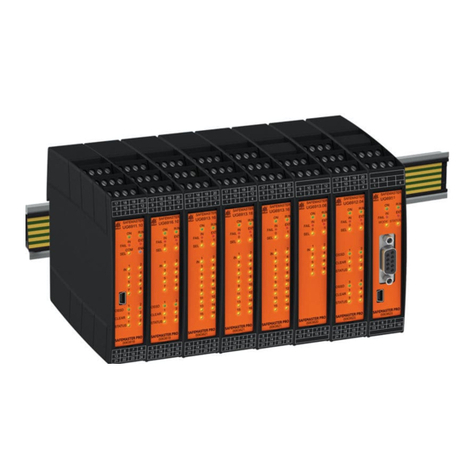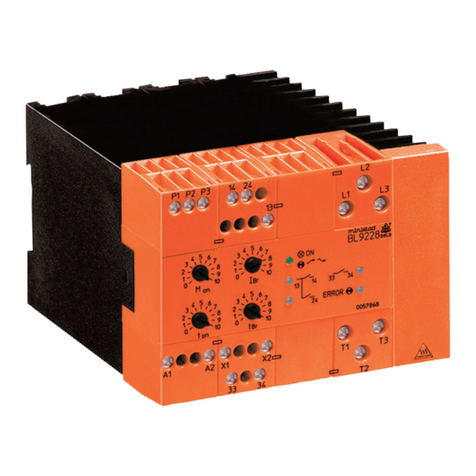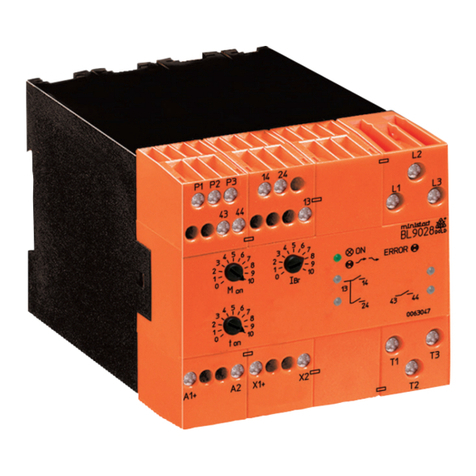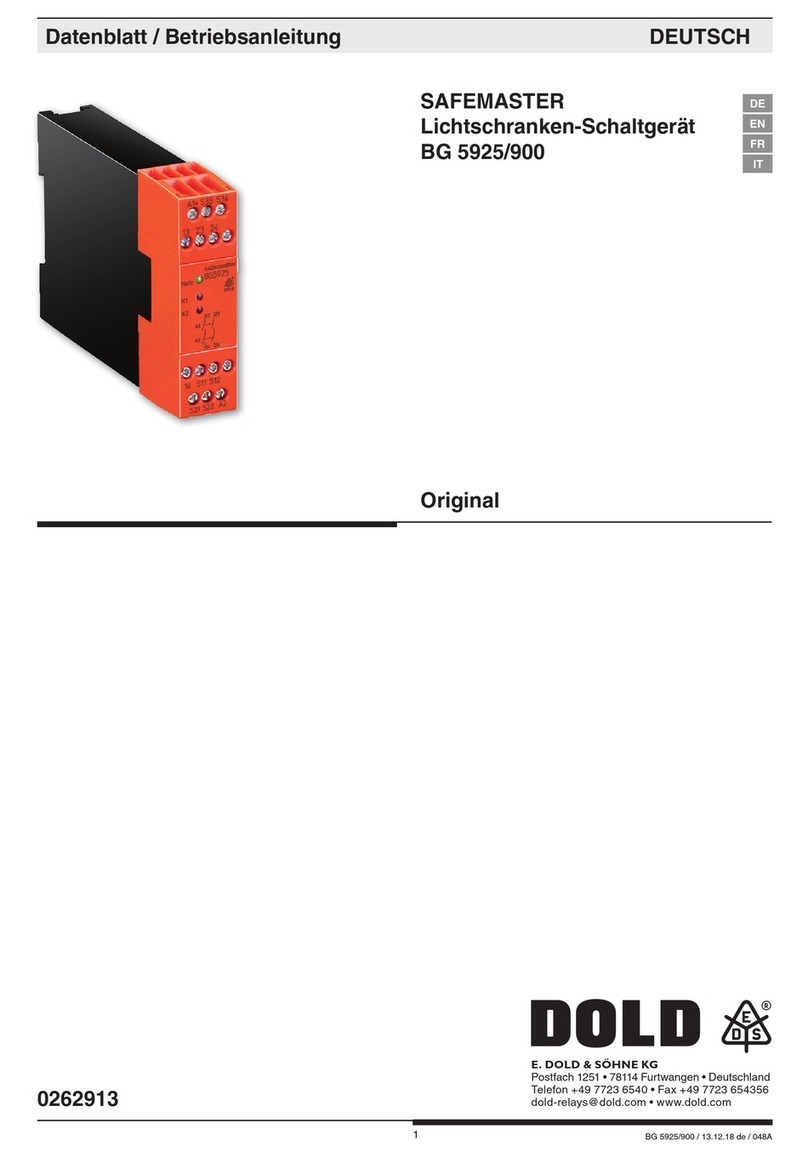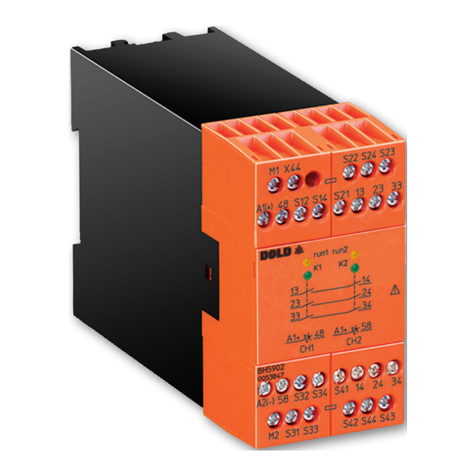
1BH 5902/01MF2 / 151123 / 613
Betriebsanleitung DEUTSCH
0262834
Vor der Installation, dem Betrieb oder der Wartung des Geräts muss diese
Anleitung gelesen und verstanden werden.
GEFAHR
VORSICHT
Gefährliche Spannung.
Lebensgefahr oder schwere Verletzungsgefahr.
Vor Beginn der Arbeiten Anlage und Gerät spannungsfrei
schalten.
Eine sichere Gerätefunktion ist nur mit zertifizierten Komponenten
gewährleistet!
Hinweise
Die hier beschriebenen Produkte wurden entwickelt, um als Teil einer
Gesamtanlage oder Maschine sicherheitsgerichtete Funktionen zu
übernehmen. Ein komplettes sicherheitsgerichtetes System enthält in
der Regel Sensoren, Auswerteeinheiten, Meldegeräte und Konzepte für
sichere Abschaltungen. Es liegt im Verantwortungsbereich des Herstellers
einer Anlage oder Maschine die korrekte Gesamtfunktion sicherzustellen.
DOLD ist nicht in der Lage, alle Eigenschaften einer Gesamtanlage oder
Maschine, die nicht durch DOLD konzipiert wurde, zu garantieren. Das
Gesamtkonzept der Steuerung, in die das Gerät eingebunden ist, ist vom
Benutzer zu validieren. DOLD übernimmt auch keine Haftung für Empfeh-
lungen, die durch die nachfolgende Beschreibung gegeben bzw. impliziert
werden. Aufgrund der nachfolgenden Beschreibung können keine neuen,
überdieallgemeinenDOLD-Lieferbedingungenhinausgehenden,Garantie-,
Gewährleistungs- oder Haftungsansprüche abgeleitet werden.
Sicherheitsbestimmungen
- Das Gerät darf nur von sachkundigen Personen installiert und in Betrieb
genommen werden, die mit dieser Betriebsanleitung und den geltenden
Vorschriften über Arbeitssicherheit und Unfallverhütung vertraut sind.
- Beachten Sie die VDE- sowie die örtlichen Vorschriften, insbesondere
hinsichtlich Schutzmaßnahmen.
- DerBerührungsschutzderangeschlossenenElementeunddieIsolationder
Zuleitungen sind für die höchste am Gerät anliegende Spannung auszulegen.
- Durch Öffnen des Gehäuses oder eigenmächtige Umbauten erlischt
jegliche Gewährleistung.
- Montieren Sie das Gerät in einen Schaltschrank mit Schutzart IP 54 oder
besser; Staub und Feuchtigkeit können sonst zu Beeinträchtigungen
der Funktionen führen.
- Sorgen Sie an allen Ausgangskontakten bei kapazitiven und induktiven
Lasten für eine ausreichende Schutzbeschaltung.
- Die Sicherheitsfunktion muss mindestens einmal im Monat ausgelöst werden.
Das BH 5902/01MF2 dient dem sicherheitsgerichteten Unterbrechen eines
Sicherheitsstromkreises.Es kann im Schutz-, Muting- und Taktbetrieb zum
Schutz von Personen und Maschinen in Anwendungen mit Lichtgittern
verwendet werden.
Bei bestimmungsgemäßer Verwendung und Beachtung dieser Anleitung
sind keine Restrisiken bekannt. Bei Nichtbeachtung kann es zu Personen-
und Sachschäden kommen.
Bestimmungsgemäße Verwendung
Praxishinweise
•Vor dem Abnehmen der Platte an der Frontseite muss für einen Poten-
tialausgleich gesorgt werden.
•Bei Mutingbetrieb muss die Mutingleuchte den Angaben der
EN 61496-1 Abschnitt A7.4 entsprechen.
•Wird eine BWS nicht benötigt, müssen jeweils 2 Brücken für jede nicht
benötigte BWS gemäß Bild 9 an die Anschlussklemmen S-1/S-2 und
S-4/S-3 gesetzt werden.
Sicherheitshinweise
ACHTUNG!
•Beim BH 5902.22 darf der Öffnerkontakt 31 - 32 nur als Meldesignal
verwendet werden.
•Nicht geeignet für Anlagen bei denen die BWS hintertretbar sein soll
•Einstellungen am Gerät sind vom Fachpersonal im spannungslosen
Zustand durchzuführen.
Anschlussklemmen
Klemmenbezeichnung Signalbeschreibung
A1+ + / L
A2 - / N
S12, S14, S22, S24, S32, S34,
S42, S44, M1, M2 Steuereingänge
S21, S23, S31, S33, S33, S41, S43 Steuerausgänge
13, 14, 23, 24, 33, 34 Schließer zwangsgeführt für
Freigabekreis
31,32 Öffner zwangsgeführt für
Meldesignal
48, 58 Halbleiter-Meldeausgang
X44 freie Verbindungsklemme,
potentialfrei
Geräteeigenschaften
•entspricht
- Performance Level (PL) e und Kategorie 4 nach EN ISO 13849-1: 2008
- SIL-Anspruchsgrenze (SIL CL) 3 nach IEC/EN 62061
- Safety Integrity Level (SIL) 3 nach IEC/EN 61508
- Kategorie 4 nach EN 954-1
•zum Anschluss von max.
- 3 BWS (berührungslos wirkende Schutzeinrichtung) 2-kanalig oder
- 2 BWS 2-kanalig und 2 Muting-Sensoren 1-kanalig oder
- 1 BWS 2-kanalig und 4 Muting-Sensoren 1-kanalig oder
- 2 BWS 2-kanalig und Schlüsselschalter für Taktumschaltung
- zusätzlich: Start-Taster und Maschinenkontakt mit Leitungs-
schlusserkennung
•Drahtbrucherkennung des BWS-Anschlusses
•Ausgänge:
- 3 Schließer oder 2 Schließer und 1 Öffner
- 2 Halbleiterausgänge, kurzschlussfest und überlastsicher
•Multifunktionsgerät, umschaltbar über Drehschalter für die
Betriebsarten:
- Schutzbetrieb, z. B. Lichtvorhänge
- Schutzbetrieb mit Muting, z. B. Förderbänder
* Einstellung unterschiedlicher Signalfolgen der Muting-Sensoren
* Einstellbarkeit der max. zulässigen Mutingzeit
* Override-Funktion über Starttaster
- Taktbetrieb, z. B: Pressen
* wahlweise 1, 2 oder 3 Takte
* Taktzahl-Einstellung wahlweise mit Schlüsselschalter
•geeignet für den Anschluss von BWS Typ 4 oder von getesteten
BWS Typ 2 gemäß IEC/EN 61 496-1, Querschlusserkennung in BWS
•mit Unter- und Überspannungserkennung und -signalisierung
•Reaktionszeiten: max. 30 ms
•LED-Anzeigen für RUN-Betrieb, Kanal 1/2
SAFEMASTER
Lichtgittermodul mit umschaltbaren Funktionen
BH 5902/01MF2 Originalbetriebsanleitung
Alle Angaben in dieser Liste entsprechen dem technischen Stand zum Zeitpunkt der Ausgabe.
Technische Verbesserungen und Änderungen behalten wir uns jederzeit vor.

